Much of the views expressed in this piece have been framed after extensive reading of the transcripts of various talks given by Mr. Charlie Munger, vice-chairman of Berkshire Hathaway Inc., and other material. I am grateful to Outstanding Investor Digest, Futile France, and of course, Mr. Munger himself, for making much of these materials available to me.
A few months ago, I gave a talk to my students at MDI on Capital Asset Pricing Model (CAPM) and the insanities that arise from that model. Here I summarise some portions of that talk, using Mr. Munger's approach to thinking - the multidisciplinary approach.
What have the seven deadly sins, or rather one of the seven deadly sins, got to do with CAPM? According to Mr. Munger, lots. Let us look at the seven deadly sins from a value investor's viewpoint ;) In other words, we'll examine the upside-downside ratio of each of the seven deadly sins.
Of the seven deadly sins - Pride, Gluttony, Lust, Anger, Greed, Sloth, and Envy - there is only one sin which has no upside associated with it. Which one? Pride? No. An excessively proud person does get some kick out of his behaviour. Same with gluttony. A glutton may become sick after his gluttonous behaviour, but at the moment of eating, he is really liking it. Lust? Of course not - no explanations needed here! Anger? No again. Everyone knows how nice it feels occasionally to vent one's anger. Greed? No again, as Gekko put it "greed is good" and often it is. Sloth? Nyet - every couch potato knows and experiences the upside of sloth. So, using backward thinking ;) we're left with the last sin on the list - the deadliest of the seven deadly sins - ENVY.
Envy is the only sin out of the seven deadly sins that gives no upside at all - no kick at all - to its practitioner. The envious people in the world are miserable people because there is only downside risk, and no upside reward in being envious. Looked from an investor's viewpoint, the lesson is simple: if you want to conquer the seven deadly sins, the first one to conquer is envy. And, maybe, the only one to conquer is envy. ;)
Now, what has all this to do with CAPM and circle of competence? Lots, according to Mr. Munger. Lets see how.
CAPM tells us how to allocate capital. The simple idea behind CAPM is that projects that are expected to earn a return on capital which exceeds the cost of capital should be accepted i.e. capital should be allocated towards them. Conversely, projects that are expected to earn a return which is less than the cost of capital, must be rejected.
So far, so good. The idea that projects which earn more than their cost of capital should be accepted, and vice versa, is a good idea. Indeed, it is derived from Mr. Munger's mental model from microeconomics - Opportunity Cost.
And since CAPM is a widely-accepted model of capital allocation around the world, which projects get capital allocated to them, and which don't, depends to a large degree on how the cost of capital is calculated. Two questions arise here:
- What if CAPM miscalculates cost of capital?
- What happens to projects that promise to deliver high real returns which are still less than the cost of capital (mis)calculated using CAPM?
The first question pertains to the appropriateness of using CAPM to calculate cost of capital. And, both Mr. Munger and Mr. Buffett, have, for years, been trying to demolish the idea that CAPM is a good model for estimating opportunity cost. The reason they provide is that CAPM estimates cost of equity capital by using beta as the proxy for risk and beta, in their view, has nothing to do with risk - a term they define as the probability of permanent long-term capital loss. Their views on this subject are well known (for example see section titled "Common Stock Investments" in Mr. Buffett's 1993 letter to BRK shareholders) , and, therefore, I would like to move on to the second question in the above list.
The second question is this:
What happens to projects that promise to deliver high real returns which are still less than the cost of capital (mis)calculated using CAPM?
Well, the answer to that question is that such projects will be rejected.
But should they really be rejected? Should we reject projects that are within our circle of competence and which promise to deliver a return of 20% p.a. just because some other projects that are outside our circle of competence promise to deliver a higher return, say 25% p.a? In other words, should we allocate capital based on our own ability to understand the fundamental economics of the project, or should we look over the fence to see what the other fellow is doing, and if he is doing better than us in things we do not understand, should we feel envious and not do something sensible that will, over time, make us rich? To quote Mr. Munger, who said the following in 2000:
“There’s one big truth that the typical investment counselor will have difficulty recognizing but the guy who’s investing his own money ought to have no trouble recognizing: If you’re comfortably rich and you’ve got a way of investing your money that is overwhelmingly likely to keep you comfortably rich and someone else finds some rapidly growing something-or-other and is getting richer a lot faster than you are, that is not a big tragedy. And if you’re not comfortable and don’t understand the fact that somebody else is getting rich faster, so what? How crazy it would be to be made miserable by the fact that someone else is doing better because someone else is always going to be doing better at any human activity you can name. Even Tiger Woods loses a lot of the time.”
And, on another occasion, he said:
“Suppose, any one of you knew of a wonderful thing right now that you were overwhelmingly confident- and correctly so- would produce about 12% per annum compounded as far as you could see. Now, if you actually had that available, and by going into it you were forfeiting all opportunities to make money faster- there’re a lot of you who wouldn’t like that. But a lot of you would think, “What the hell do I care if somebody else makes money faster?” There’s always going to be somebody who is making money faster, running the mile faster or what have you. So in a human sense, once you get something that works fine in your life, the idea of caring terribly that somebody else is making money faster strikes me as insane.”
Apart from envy, Mr. Munger, of course, is referring to the fundamental ignorance of an enormously important mental model from mathematics - the power of long-term compounding. Even small sums of money, when compounded at a rapid rate over the long term, become enormous, regardless of how much more rapidly, someone else is compouning money. And, if you are competent enough to compound money at a rapid rate, simple arithemetic shows that you're going to become rich. And if that outcome is virtually certain, then how in the hell does it matter, if someone else got richer than you? Of course, it doesn't. But try telling that to the capital allocators of the world - corporate boards or investment commitees of institutional money managers.
The Munger-Buffett system, which draws on mental models from multiple disciplines is far more simple, and roughly right, than esoteric models like CAPM, which are precise, but wrong. The mental models in the Munger-Buffett system are:
- Envy from Psychology - Don't be envious of other people's success.
- Opportunity cost from Microeconomics - Considering opportunity cost in allocation-of-capital decisions is critical but using CAPM to determine your opportunity cost is foolish. Moreover, the opportunity cost model must be used together with the circle of competence model (see below).
- Compound interest from Mathematics - Absolute compounding works wonders in the long run.
- Circle of Competence (specialisation) from Economics - Things that you are incapable of understanding, should not form part of the opportunity set from which you determine your own opportunity cost.
As a deep value investor, I have learnt, as Keynes put it, that its better to be roughly right than to be precisely wrong. By using the above, correct and simple framework, and by keeping away from CAPM's complexities and the insanities that arise from that model, I've done pretty well. Now, if someone has done even better than me in IPOs or high-technology, or pharmaceauticals - about which I know little - why in the world should I care?



